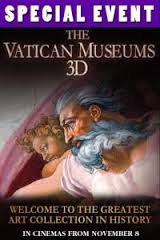
THE VATICAN MUSEUMS 3D
This is a documentary being screened at special cinemas, described as An Event, in the vein of the screenings of plays from the National Theatre in London or operas from Lincoln Centre in New York City. It is an Italian production, hosted by the director of the Vatican Museums.
It is said that millions of tourists visit the Vatican museums, especially the Sistine Chapel, each year. But this means that many more millions do not have the opportunity to visit the museums and wonder at the paintings, statues, frescoes. And, even when we might have an opportunity to do this visit, there is so much to see, so many crowds, not as much time as we might have hoped, and we achieve some glimpses of the works of art. This means that this documentary is a kind of supplement for those who have visited and, hopefully, an eye-opener for those who have yet to visit.
The director explains the origins of the Vatican museums, the discovery of the classic statue of the priest, Laacoon, and the serpents, in the 15th century and Pope Julius the second, the Pope who hired Michelangelo to paint the Sistine Chapel roof, establishing the museums.
The first part of the tour is a look at the classical statues from the Greek and Roman period. While interesting in themselves, they serve as a prelude to what most audiences would be wanting to see, the mediaeval paintings and the Sistine Chapel.
The director does a commentary in Italian, with a voice-over, rather plain and less-than-involving, giving the information in English. It is a pity that one can still hear, as with television and radio news, the original voice underlying the voice-over.
But the main part of the film is quite exhilarating. The 3D is effective in showing the scope of the museums, the vast corridors, the rooms full of paintings, the Sistine Chapel. But it also has the strange effect, when we look at paintings in close-up, of producing 3 De effect on the paintings themselves which is not what we see when we look at them up close.
The main benefits of the film are the time spent with Raphael’s paintings and with Michelangelo’s. Audiences may not be so familiar with Raphael’s paintings and this is a wonderful opportunity to see some of his great works, huge paintings in the Vatican halls, in their large perspective as well as in detailed close-up. Audiences will be in great admiration of the work of Raphael.
But then, there is the Sistine Chapel, a look at some of the key paintings on the roof of as well as time spent gazing at the overall impact of Michelangelo’s The Last Judgement as well as appreciating so much of the detail. One of the difficulties with the commentary is that as soon as the director does some explanation of a particular part of the painting, the film editors cut immediately to the next sequence, whisking us away, without giving the audience sufficient time to look and to appreciate what they have just heard.
Statistics are given about the length of the corridors, the size of the rooms, the number of works of art in the museum, with some glimpses of the work of other painters, including van Gough. But it is the paintings of Raphael and Michelangelo that audiences will be happy to have had the opportunity